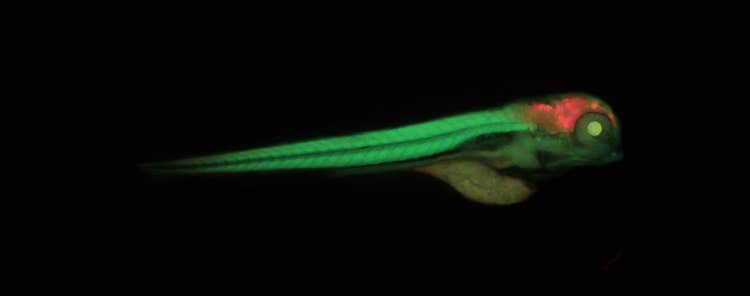
Molecular Devices의 혁신: 자동화 High-Content Imaging 업데이트
From customer feedback to workflow improvements
The path to understanding complex biological processes and diseases is paved with a lot of challenges. As the desired level of insight increased, so did the requirements from state-of-art laboratory solutions. That’s why solutions that worked last year may be inadequate in solving today’s research questions.
For Molecular Devices, the most efficient way of following up with scientific demand was to keep in touch with its customers, those at the center of science. Paying close attention to the complex research goals and methods of collaborators, Molecular Devices implemented several updates on its high-content imaging and analysis solutions.
This article summarizes the recent product updates and the customer feedback that drove these very updates.
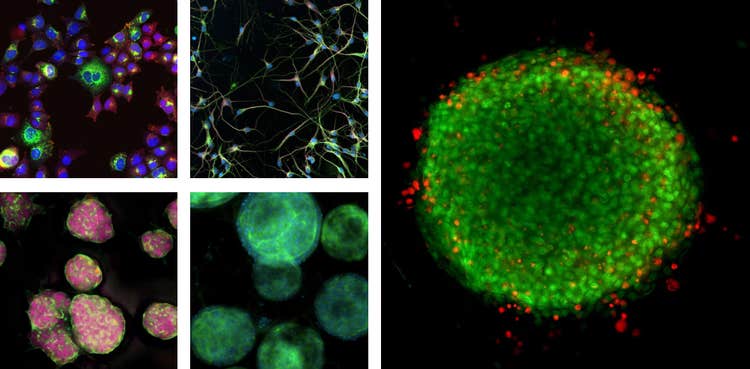
자동 초점
The paradigm shift from manual to automated microscopy required a new combination of hardware and software tools required to accelerate discovery. In particular, automated microscopy must detect and define the interface between the adherent cells or medium and the bottom of the plate, and then maintain this optimal focus position across an entire microplate or slide. For some substrates, such as Matrigel® for organoid development and well inserts, the task was even bigger.
Molecular Devices updated its CellReporterXpress® Image Acquisition and Analysis Software to provide the ImageXpress® Pico Automated Cell Imaging System with additional autofocus modes to further expand its capabilities. The solution offers multiple autofocus modes that are optimized for a wide-range of applications and labware types, from ultra-thin round bottom microplates, custom organ-on-a-chip plates, to thick bottom culture plates, and plates with well inserts. In addition, the autofocus modes differ in their use cases – the objective and labware type being imaged – thus providing the ImageXpress Pico system with the flexibility to reliably focus on a wide-variety of samples.
The CellReporterXpress update consisted of new hardware and software autofocus features. The hardware autofocus improvements involve reflectivity detection, during which the autofocus LED is used to find two reflection points at the air-plastic bottom interface and the plastic-liquid interface. The CellReporterXpress-specific algorithms then utilize these two points to find the exact interaction point for proper focus.
표면 알고리즘 측정
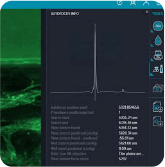
플레이트 바닥
Hardware autofocus detects the surface closest to the objective (that is, the plate bottom). 낮은 배율로 Imaging하거나 실험기구의 바닥이 두꺼운 경우 플레이트 또는 챔버 Slide의 부착성 샘플에 적합합니다. 이것은 가장 빠른 속도의 하드웨어 자동 초점 옵션입니다.
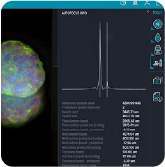
Well 바닥
Hardware autofocus detects the two surfaces closest to the objective (that is, the plate bottom and well bottom). Well 바닥 옵션은 Well 플레이트 또는 챔버 Slide와 같은 액체 배지 샘플용으로 설계되었습니다. 이는 가장 일반적으로 사용되는 하드웨어 자동 초점 옵션입니다.
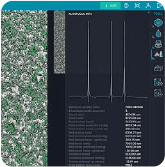
Well 인서트
Hardware autofocus detects the three surfaces closest to the objective (that is, the plate bottom, well bottom, and well insert). Well 인서트 옵션은 Well 플레이트의 Well 인서트나 구분되는 제 3의 표면이 존재하는 모든 실험기구 디자인용으로 설계되었습니다.
In some cases, the highest-contrast imaging focal plane differed from the bottom of the plate. To account for this, Molecular Devices introduced software autofocus routines with varying search ranges to CellReporterXpress, which could find the highest-contrast imaging focal plane automatically.
Learn more about unique and innovative autofocus modes like the 3 Peak Well Insert mode. As well as focus modes designed to enhance acquisition speed, Anchor Focus Position, when imaging samples at low magnification for screening or for large macroscopic samples.
From widefield to digital confocal
One of the main goals at Molecular Devices is to provide cutting-edge imaging solutions for a broad spectrum of researchers. The ImageXpress Pico system is one of our products that the word affordability has been strongly emphasized. In the continuum of imaging products within the Molecular Devices portfolio, speed, flexibility, and resolution, are the main distinguishing features as you move from the ImageXpress Pico system to the flagship ImageXpress® Confocal HT.ai High-Content Imaging System.
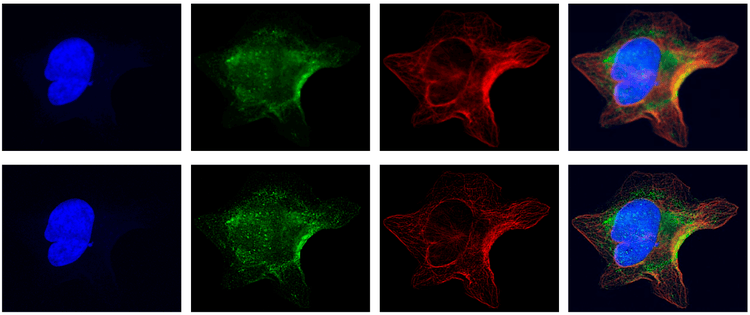
획득 도중 디지털 공초점 옵션을 이용한 이미지(하단)는 해당 옵션을 사용하지 않은 이미지(상단)보다 세포 구조를 보다 명확하게 보여주며, 더 로버스트한 이미지 분석이 가능합니다.
In the case of resolution, we introduced software updates that helped generate confocal-like images from widefield microscopy acquisition. We introduced a restorative image deconvolution method, digital confocal, that quantitatively reassigns out-of-focus light to its original point of origin. Utilizing the point spread function calculated from the specific optical path and objective, the microscopist can designate individual acquisitions to take advantage of increased resolution. Another significant benefit is reduced acquisition time, which meant that phototoxicity risk would also be reduced. Last, but not least, signal-to-noise is enhanced enabling much easier quantification of the images.
Live pre-view
Another difference of automated microscopes, in general, was that they did not offer the traditional freedom of movement associated with standard microscope workflows. This created a different user experience, especially in slide-based workflows and cell migration imaging.
The CellReporterXpress software’s new Live Preview feature was developed to tackle this challenge. With Live Preview, using the same camera utilized for acquiring images, the user can now move the sample stage to explore a continually updated, dynamic image of the sample with a virtual joystick, mimicking the traditional experience.
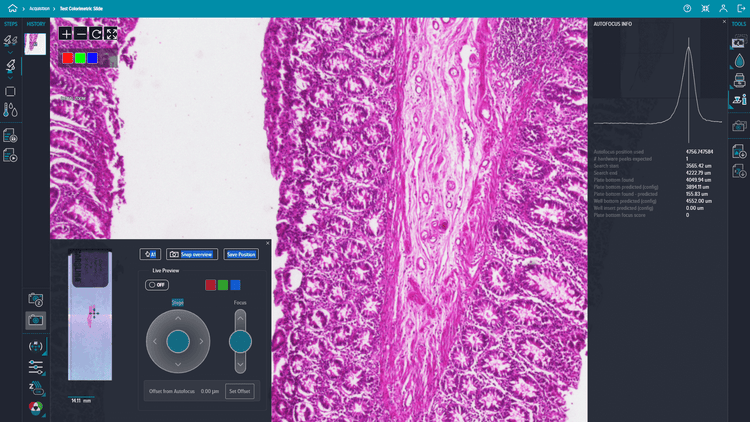
The feature boasts two virtual joysticks that you can use to move around and determine your region of interest at low magnification before image acquisition. The snap overview add-on uses a planetary overview camera to take a snapshot of the entire slide. That way, the user can easily locate their sample on the slide. Once you find the region of interest, the joystick will then help you to seamlessly switch to high magnification for adjusting focus.
EC(Environmental Control)
Clinically relevant disease models are becoming increasingly significant for mimicking in vivo conditions. This created a shift from endpoint and fixed cell assays to fluorescent or label-free live-cell assays; however, this required thorough control and monitoring of the microclimate around the plates, which is particularly challenging in many imaging systems.

The Environmental Control features in the ImageXpress Pico system provide complete control of the climate, including CO2, humidity, temperature, and O2 (which is extremely useful in modeling hypoxia-based studies, such as those involving tumoroids). Furthermore, the live recording of environmental control sensors enabled users to verify that their cells are being maintained in the ideal microclimate.
The EC settings also enable kinetic acquisitions with multiple time points for different time lengths. The user can generate movies, images, and kinetic data across time, all of which are suitable for export.
Preconfigured protocols with on-the-fly analysis of multiparametric data
Save time and reduce errors with preconfigured analysis protocols that generate robust multiparametric data for a majority of the most common cell-based assays with CellReporterXpress, enabling on-the-fly analysis
Microplate readers have long proven efficient in drug screening and toxicity analysis; however, they are also limited in the information they give, which is fluorescence unit per well. When customers also wanted to track morphology changes and cell behavior in disease models, imaging modalities became critical to compliment the well based data provided by traditional microplate readers.
CellReporterXpress is preinstalled with over 25 preconfigured analysis protocols ranging from simple cell counting to sophisticated multi wavelength cell scoring, and neurite tracing analysis. 클릭 기능 검색 도구와 같은 기능을 통해, 특정 기준에 맞는 몇 개의 세포를 클릭하기만 해도 분석 Parameter를 최적화할 수 있습니다. Allowing for the use of high content analysis techniques to stratify cell populations.
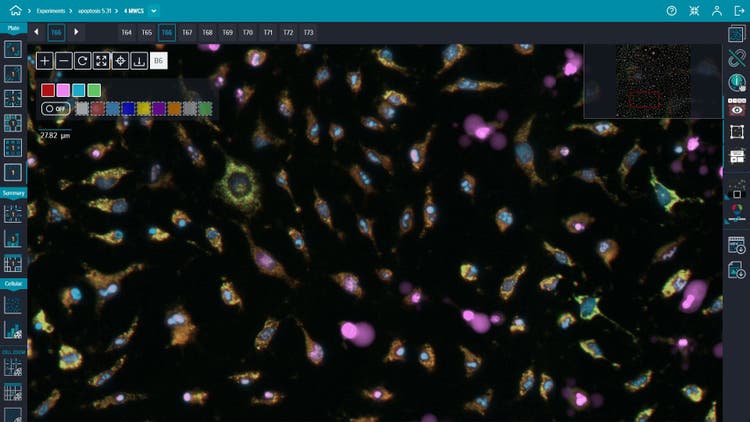
For more complex analyses, images captured with the ImageXpress Pico system are compatible with our other Molecular Devices advanced analysis software. The updates in IN Carta® Image Analysis Software and MetaXpress® High-Content Imaging Acquisition and Analysis Software aimed to ease the stratification process. This created a more informed scoring system based on multiple markers within the cell. As for IN Carta software, the SINAP module made use of deep learning algorithms to improve accuracy and flexibility.
In both updates, the user gained a better ability to profile and cluster cell groups, acquire and interpret images, and export & share the resulting graphs.
High-Content Screening을 위한 실험실 자동화
Through this paradigm shift to automated imaging, researchers now had access to increased screening throughput utilizing microscopy. The accelerated imaging process naturally necessitated the need for including laboratory automation with the flexibility for novel experimental setups. While some customers wanted to drastically increase their sample size for higher statistical confidence, others wanted to investigate varied disease models with multiple cell lines with a single workflow. The plethora of workflow demands meant that Molecular Devices needed to create customized workflows for various research needs.
https://share.vidyard.com/watch/261PZTTCKAUFtD7skdrw2M
See the Automated ImageXpress Pico system workflow in action
That’s where the automation and customization team came to the rescue. The team provides streamlined workflows that will meet your specific research requirements in the most time-efficient way. The team can modify Molecular Devices’ microplate readers and high-content imaging systems, as well as pair these instruments with automated incubators and liquid handling into seamless workflows. Their workflow customization services involve a wide range of hardware and software modifications, such as the following:
- Robotics - so you can move plates in and out of the imaging platform with ease
- Installation of liquid handling workstations
- Automated reagent addition
- Automated incubator setup
- Validation testing
The best part of our automation and customization services is the in-house expertise in instrument and workflow design and continuous support during the consultation, feasibility testing, and implementation.
Organoid Innovation Center: Where motivation meets expertise
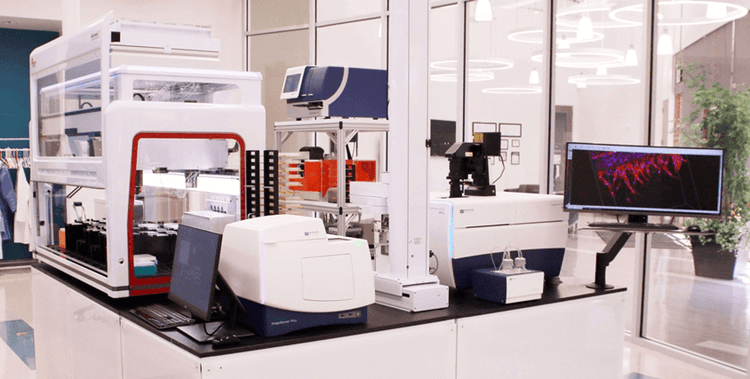
The relation between Molecular Devices and its customers is bi-directional. As our innovative approach continues to launch products and solutions, our customers continue to thrive in accelerating their research. This drives them to explore more and us to work harder to meet more challenging research questions.
Our new Organoid Innovation Center constitutes a perfect simulation of the compelling customer-team-product relations. To meet research needs for complex 3D biology, we are constantly on the move to keep our imaging and analysis tools up to date. Furthermore, our in-house scientists are available to collaborate with you and provide uninterrupted guidance.
If you are interested in creating an automated workflow for your organoid research, visit our Organoid Innovation Center to learn more about our products and services.